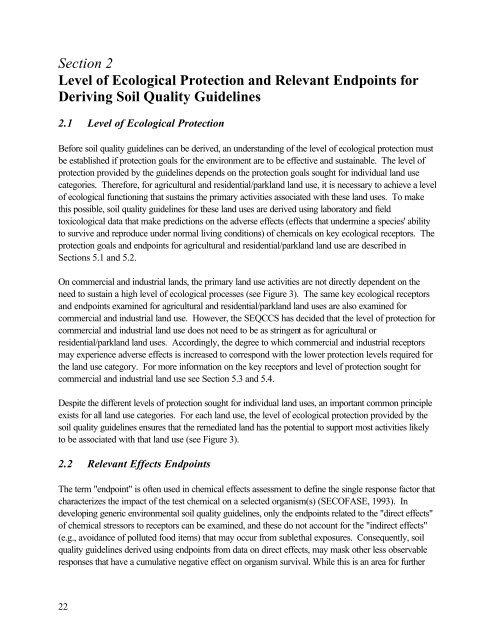Protocol for the Derivation of Environmental and Human ... - CCME
Protocol for the Derivation of Environmental and Human ... - CCME
Protocol for the Derivation of Environmental and Human ... - CCME
Create successful ePaper yourself
Turn your PDF publications into a flip-book with our unique Google optimized e-Paper software.
Section 2<br />
Level <strong>of</strong> Ecological Protection <strong>and</strong> Relevant Endpoints <strong>for</strong><br />
Deriving Soil Quality Guidelines<br />
2.1 Level <strong>of</strong> Ecological Protection<br />
Be<strong>for</strong>e soil quality guidelines can be derived, an underst<strong>and</strong>ing <strong>of</strong> <strong>the</strong> level <strong>of</strong> ecological protection must<br />
be established if protection goals <strong>for</strong> <strong>the</strong> environment are to be effective <strong>and</strong> sustainable. The level <strong>of</strong><br />
protection provided by <strong>the</strong> guidelines depends on <strong>the</strong> protection goals sought <strong>for</strong> individual l<strong>and</strong> use<br />
categories. There<strong>for</strong>e, <strong>for</strong> agricultural <strong>and</strong> residential/parkl<strong>and</strong> l<strong>and</strong> use, it is necessary to achieve a level<br />
<strong>of</strong> ecological functioning that sustains <strong>the</strong> primary activities associated with <strong>the</strong>se l<strong>and</strong> uses. To make<br />
this possible, soil quality guidelines <strong>for</strong> <strong>the</strong>se l<strong>and</strong> uses are derived using laboratory <strong>and</strong> field<br />
toxicological data that make predictions on <strong>the</strong> adverse effects (effects that undermine a species' ability<br />
to survive <strong>and</strong> reproduce under normal living conditions) <strong>of</strong> chemicals on key ecological receptors. The<br />
protection goals <strong>and</strong> endpoints <strong>for</strong> agricultural <strong>and</strong> residential/parkl<strong>and</strong> l<strong>and</strong> use are described in<br />
Sections 5.1 <strong>and</strong> 5.2.<br />
On commercial <strong>and</strong> industrial l<strong>and</strong>s, <strong>the</strong> primary l<strong>and</strong> use activities are not directly dependent on <strong>the</strong><br />
need to sustain a high level <strong>of</strong> ecological processes (see Figure 3). The same key ecological receptors<br />
<strong>and</strong> endpoints examined <strong>for</strong> agricultural <strong>and</strong> residential/parkl<strong>and</strong> l<strong>and</strong> uses are also examined <strong>for</strong><br />
commercial <strong>and</strong> industrial l<strong>and</strong> use. However, <strong>the</strong> SEQCCS has decided that <strong>the</strong> level <strong>of</strong> protection <strong>for</strong><br />
commercial <strong>and</strong> industrial l<strong>and</strong> use does not need to be as stringent as <strong>for</strong> agricultural or<br />
residential/parkl<strong>and</strong> l<strong>and</strong> uses. Accordingly, <strong>the</strong> degree to which commercial <strong>and</strong> industrial receptors<br />
may experience adverse effects is increased to correspond with <strong>the</strong> lower protection levels required <strong>for</strong><br />
<strong>the</strong> l<strong>and</strong> use category. For more in<strong>for</strong>mation on <strong>the</strong> key receptors <strong>and</strong> level <strong>of</strong> protection sought <strong>for</strong><br />
commercial <strong>and</strong> industrial l<strong>and</strong> use see Section 5.3 <strong>and</strong> 5.4.<br />
Despite <strong>the</strong> different levels <strong>of</strong> protection sought <strong>for</strong> individual l<strong>and</strong> uses, an important common principle<br />
exists <strong>for</strong> all l<strong>and</strong> use categories. For each l<strong>and</strong> use, <strong>the</strong> level <strong>of</strong> ecological protection provided by <strong>the</strong><br />
soil quality guidelines ensures that <strong>the</strong> remediated l<strong>and</strong> has <strong>the</strong> potential to support most activities likely<br />
to be associated with that l<strong>and</strong> use (see Figure 3).<br />
2.2 Relevant Effects Endpoints<br />
The term "endpoint" is <strong>of</strong>ten used in chemical effects assessment to define <strong>the</strong> single response factor that<br />
characterizes <strong>the</strong> impact <strong>of</strong> <strong>the</strong> test chemical on a selected organism(s) (SECOFASE, 1993). In<br />
developing generic environmental soil quality guidelines, only <strong>the</strong> endpoints related to <strong>the</strong> "direct effects"<br />
<strong>of</strong> chemical stressors to receptors can be examined, <strong>and</strong> <strong>the</strong>se do not account <strong>for</strong> <strong>the</strong> "indirect effects"<br />
(e.g., avoidance <strong>of</strong> polluted food items) that may occur from sublethal exposures. Consequently, soil<br />
quality guidelines derived using endpoints from data on direct effects, may mask o<strong>the</strong>r less observable<br />
responses that have a cumulative negative effect on organism survival. While this is an area <strong>for</strong> fur<strong>the</strong>r<br />
22
















